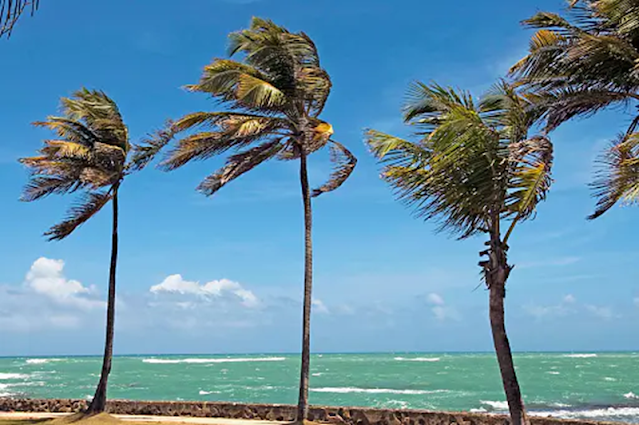#6 LAND AND SEA BREEZE
Land and Sea Breeze
On a hot early afternoon, take a walk along a
dry beach. You start hopping and leaping as soon as you place your bare feet in
the sand and sprint towards the sea to soak your burning feet in the water.
Yes, the sun warms them both. Land and water, on the other hand, do not heat up
or cool down at the same rate. In coastal areas, the differential heating and
cooling of land and water create breezes. A sea breeze is any wind that blows
from a large water body towards a landmass. Whereas, the offshore winds are
called a land breeze that arises from land. The main difference is because of
the property of water to retain heat for a longer duration as compared to land.
Here, we will discuss more about the land and sea breeze along with some
important questions.
What is a Breeze?
Breeze, the light and cold wind is one of the
most wonderful sensations to feel a cold and moderate wind on a hot summer day
at the beach.
The breeze is classified into two types:
- Sea Breeze
- Land Breeze
The primary distinction between the two forms
of Breeze is that water maintains heat for a longer period of time. The
temperature differential between land and water produces a change in the
density of the air over their respective surfaces. The Breeze is generated by
the alternating airflow induced by the consequent low pressure. People who live
near the shore get cold sea breezes during the day and warm land breezes at
night. These breezes also have an impact on the temperature, humidity, and
precipitation rates.
What is Land Breeze?
A land breeze or offshore wind is the flow of
wind from land to the water body. This procedure continues throughout the
night, and the preceding process is reversed. When the sun sets, both the land
and the water begin to chill. Because the heat capacity of the land differs
from that of the water, it cools down faster. As a result of the greater
temperature over the water compared to the land, a low-pressure condition
occurs over the sea. As a result, air rushes from the land to the sea, giving
rise to the phrase "land breeze."
How Does Land Breeze Occur?
The following diagram depicts how the land
wind is formed:
- Because there is no sun to give
heat throughout the night, the land cools fast and warms up the
surrounding air.
- However, as compared to land,
aquatic bodies hold heat for a longer period of time, causing the air
above them to have a lower density and rise.
- High pressure builds up over
the land, whereas low pressure builds up above the ocean.
- The flow of thick air over the
ground occurs over water from land to space.
- The refrigerator The breeze
originates from the coast and is known as a land breeze because the winds
flow from high pressure to low-pressure zones.
What is Sea Breeze?
Sea breeze flows during the day and this
procedure is repeated throughout the day. The sun heats both the water and the
land surface. Because the water has a considerably larger heat capacity than
the land, it heats up more slowly. As a result, the temperature over the ground
surface rises, heating the surrounding air. Expansion happens in the less dense
warm air, resulting in the formation of a low-pressure region above the
continent. At the same time, a high-pressure region forms on the sea's surface.
Because of the pressure differential, air flows from the high pressure over the
sea to the low pressure over the land. The sea breeze is the movement of air
from the sea to the land.
During the spring and summer, the sea wind is
more prominent on warm, sunny days. As a result, it has a remarkable cooling
effect and causes a considerable temperature reduction.
How does Sea Breeze
Occur?
The following formations depict the
development of a sea breeze:
- During the day, the sun quickly
heats up the ground.
- The air above the sea is cooler
than the air above the land.
- Because the warmer air above
the ground is less dense, it begins to ascend in the air.
- Low pressure is created.
- As the warm air from the land
rises, the denser air above the water rises to fill the gap above the
land. A sea breeze is a name given to this colder air.
Things to Remember
- Both winds are common near
coastal locations. The land and sea winds influence precipitation rates,
air temperature, and humidity levels.
- Land winds are caused by land,
whereas sea breezes are caused by the sea or other big bodies of water.
- The crucial difference is due to
water's ability to hold heat and warm up for a longer period of time than
land.
- Offshore winds are referred to
as a land breeze, whereas onshore winds are referred to as a sea breeze.
- A land wind occurs at night,
whereas a sea breeze occurs during the day.
- Land winds are more prevalent
in the autumn and winter months, whereas sea breezes are more prevalent in
the spring and summer months.
- Sea winds are typically
stronger than land breezes. As a result, sea breezes are extremely
essential to glider pilots and other associated aircraft operators.
- Land winds are often milder
than sea breezes.
- Land breezes are typically dry
winds, but sea breezes include more moisture.
- Land winds, as opposed to sea
breezes, are predominant throughout the winter months.
- Sea breezes, unlike land
breezes, can suggestively reduce air temperature.





Comments
Post a Comment